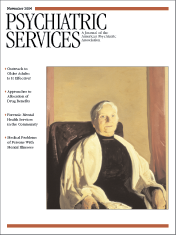Reducing Assaults Among Hospitalized Youths
To the Editor: In the June 2004 issue, Ryan and her colleagues (1) report on a study of assaults by hospitalized youths. They note the unexpected frequency with which the verbal directives of staff members served as precursors to assaults—in 68 percent of the 215 assaults in the sample. This finding, which the authors appear at some loss to explain, is of enormous clinical import given ongoing concern about how best to prevent acute aggression in inpatient settings for children and adolescents (2) as well as active efforts to reduce the use of inpatient seclusion and restraint with this population (3). As such, it warrants further consideration.
Ryan and her colleagues are probably not alone in their surprise that level-based behavioral management—that is, attempting to motivate patients by rewarding them with greater privileges for certain behaviors—appears so centrally implicated in aggressive behavior. They are also not alone in pondering whether "the very nature of limit setting" associated with such management practices "may place staff at risk of assault." For instance, a more recent model for working with explosive, aggressive youths—collaborative problem solving (CPS)—views oppositional behavior as transactional: the manner in which caregivers respond to deviations from expectations for compliance has the capacity to either ignite or defuse potential outbursts (4).
Behavioral management approaches view noncompliance as indicating a lack of motivation, which they seek to instill through rewards and consequences. In contrast, CPS views compliance as a developmental achievement and its lack as akin to a behavioral learning disorder. It therefore emphasizes discovering the specific pattern of cognitive skill deficits implicated in a given child's inability to comply and works to remediate these deficits. From this viewpoint, contingency management practices are seen as having the potential to paradoxically increase frustration and arousal—sometimes to the point of violence—among youths when they are verbally redirected. Efforts to adopt CPS within the Cambridge Health Alliance's child and adolescent assessment units, as part of a larger Massachusetts initiative to reduce the use of seclusion and restraint, were recently recognized by the American Psychiatric Association with a Gold Achievement Award (5).
It would have been quite interesting if Ryan and her colleagues had provided even a sampling of situation-specific, verbatim data on just what constituted verbal direction or redirection in the assaults in their sample. It is my experience that in retrospective accounts of childhood disruptive behavior, information about adults' words or behavior during the interaction that preceded aggressive incidents is routinely elided by reporters and rarely sought by clinicians, which masks the transactional nature of such episodes. That is, parents and other caregivers describe in excruciating detail the aggressive outburst that seems to require hospitalization, but they leave out what they did or said that may have precipitated this outcome, and clinicians rarely attempt to elicit this kind of detailed information. Both parties act as if it has no conceivable relevance.
Ryan and her colleagues have documented an urgently important finding that ought to invite the psychiatric community to ponder the enduring therapeutic utility of level-based behavioral systems.
Dr. Whelan is a staff clinician at the Cambridge Health Alliance in Cambridge, Massachusetts, where Collaborative Problem Solving has been adopted as the treatment model on the inpatient child and adolescent psychiatric units. He is also in private practice in Newton, Massachusetts.
1. Ryan EP, Hart VS, Messick DL, et al: A prospective study of assault against staff by youths in a state psychiatric hospital. Psychiatric Services 55:665–670, 2004Link, Google Scholar
2. Barnett S, dosReis S, Riddle R, et al: Improving the management of acute aggression in state residential and inpatient psychiatric facilities for youth. Journal of the American Academy of Child and Adolescent Psychiatry 41:897–905, 2002Crossref, Medline, Google Scholar
3. LeBel J, Stromberg N, Duckworth K, et al: Child and adolescent inpatient restraint reduction: a state initiative to promote strength-based care. Journal of the American Academy of Child and Adolescent Psychiatry 43:37–45, 2004Crossref, Medline, Google Scholar
4. Greene RW, Ablon JS, Goring JC: A transactional model of oppositional behavior: underpinnings of the collaborative problem solving approach. Journal of Psychosomatic Research 55:67–75, 2003Crossref, Medline, Google Scholar
5. A more compassionate model for treating children with severe mental disturbances: the Open Arms Program of the Cambridge Hospital Child Assessment Unit, Cambridge, Massachusetts. Psychiatric Services 54:1529–1531, 2003Crossref, Medline, Google Scholar



